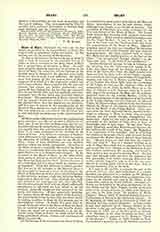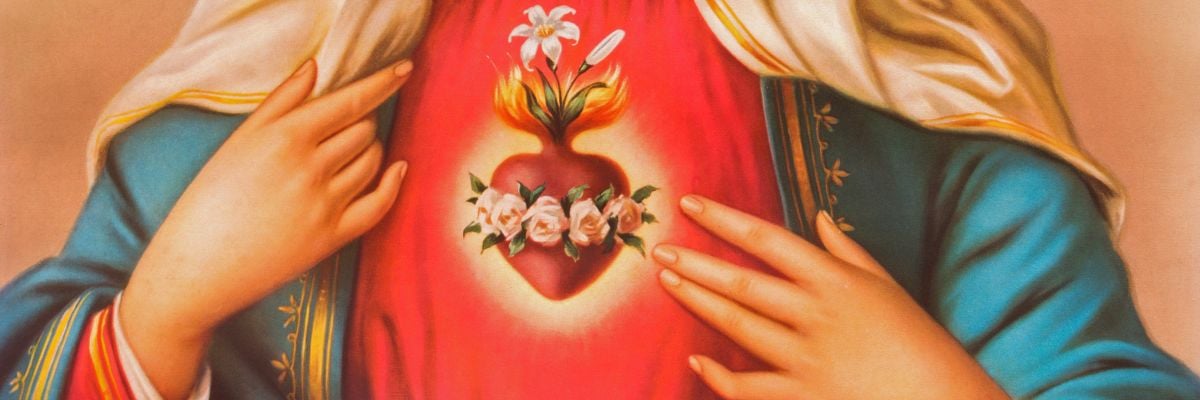

Heart of Mary, DEVOTION TO THE.—As in the article on devotion to the Sacred Heart of Jesus, this subject will be considered under two heads: (I) the nature, and (2) the history of the devotion.
Just as devotion to the Sacred Heart of Jesus is only a form of devotion to the adorable Person of Jesus, so also is devotion to the Holy Heart of Mary but a special form of devotion to Mary. In order that, properly speaking, there may be devotion to the Heart of Mary, the attention and the homage of the faithful must be directed to the physical heart itself. However, this in itself is not sufficient; the faithful must read therein all that the human heart of Mary suggests, all of which it is the expressive symbol and the living reminder: Mary’s interior life, her joys and sorrows, her virtues and hidden perfections, and, above all, her virginal love for her God, her maternal love for her Divine Son, and her motherly and compassionate love for her sinful and miserable children here below. The consideration of Mary’s interior life and the beauties of her soul, without any thought of her physical heart, does not constitute our devotion; still less does it consist in the consideration of the Heart of Mary merely as a part of her virginal body. The two elements are essential to the devotion, just as soul and body are necessary to the constitution of man.
All this is made sufficiently clear in the explanations given elsewhere (see Devotion to the Heart of Jesus), and, if our devotion to Mary must not be confounded with our devotion to Jesus, on the other hand, it is equally true that our veneration of the Heart of Mary is, as such, analogous to our worship of the Heart of Jesus. It is, however, necessary to indicate a few differences in this analogy, the better to explain the character of Catholic devotion to the Heart of Mary. Some of these differences are very marked, whereas others are barely perceptible. Devotion to the Heart of Jesus is especially directed to the Divine Heart as overflowing with love for men, and it presents this love to us as despised and outraged. In the devotion to the Heart of Mary, on the other hand, what seems to attract us above all else is the love of this Heart for Jesus and for God. Its love for men is not overlooked, but it is not so much in evidence nor so dominant. With this difference is linked another. The first act of the devotion to the Heart of Jesus is the love eager to respond to love; in devotion to the Heart of Mary there is no first act so clearly indicated: in this devotion, perhaps, study and imitation hold as important a place as love. For, although this study and imitation are impregnated with filial affection, the devotion presents itself with no object sufficiently conspicuous to call forth our love, which is, on the contrary, naturally awakened and increased by the study and imitation. Hence, accurately speaking, love is more the result than the object of the devotion, the object being rather to love God and Jesus better by uniting ourselves to Mary for this purpose and by imitating her virtues. It would also seem that, although in the devotion to the Heart of Mary the heart has an essential part as symbol and sensible object, it does not stand out as prominently as in the devotion to the Heart of Jesus; we think rather of the thing symbolized, of love, virtues, and sentiments, of Mary’s interior life.
The history of the devotion to the Heart of Mary is connected on many points with that to the Heart of Jesus; nevertheless, it has its own history which, although very simple, is not devoid of interest. The attention of Christians was early attracted by the love and virtues of the Heart of Mary. The Gospel itself invited this attention with exquisite discretion and delicacy. What was first excited was compassion for the Virgin Mother. It was, so to speak, at the foot of the Cross that the Christian heart first made the acquaintance of the Heart of Mary. Simeon‘s prophecy paved the way and furnished the devotion with one of its favorite formulae and most popular representations: the heart pierced with a sword. But Mary was not merely passive at the foot of the Cross; “she cooperated through charity”, as St. Augustine says, “in the work of our redemption”.
Another Scriptural passage to help in bringing out the devotion was the twice-repeated saying of St. Luke, that Mary kept all the sayings and doings of Jesus in her heart, that there she might ponder over them and live by them. A few of the Virgin’s sayings, also recorded in the Gospel, particularly the Magnificat, disclose new features in Marian psychology. Some of the Fathers also throw light upon the psychology of the Virgin, for instance, St. Ambrose, when in his commentary on St. Luke he holds Mary up as the ideal of virginity, and St. Ephrem, when he so poetically sings of the coming of the Magi and the welcome accorded them by the humble Mother. Little by little, in consequence of the application of the Canticle to the loving relations between God and the Blessed Virgin, the Heart of Mary came to be for the Christian Church the Heart of the Spouse of the Canticles as well as the Heart of the Virgin Mother. Some passages from the other Sapiential Books, likewise understood as referring to Mary, in whom they personify wisdom and her gentle charms, strengthened this impression. Such are the texts in which wisdom is presented as the mother of lofty love, of fear, of knowledge, and of holy hope. In the New Testament Elizabeth proclaims Mary blessed because she has believed the words of the angel; the Magnificat is an expression of her humility; and in answering the woman of the people, who in order to exalt the Son proclaimed the Mother blessed, did not Jesus himself say: “Blessed rather are they that hear the word of God and keep it”, thus in a manner inviting us to seek in Mary that which had so endeared her to God and caused her to be selected as the Mother of Jesus? The Fathers understood His meaning, and found in these words a new reason for praising Mary. St. Leo says that through faith and love she conceived her Son spiritually, even before receiving Him into her womb, and St. Augustine tells us that she was more blessed in having borne Christ in her heart than in having conceived Him in the flesh.
It is only in the twelfth, or towards the end of the eleventh, century, that slight indications of a regular devotion are perceived in a sermon by St. Bernard (De duodecim stellis), from which an extract has been taken by the Church and used in the Offices of the Compassion and of the Seven Dolors. Stronger evidences are discernible in the pious meditations on the Ave Maria and the Salve Regina, usually attributed either to St. Anselm of Lucca (d. 1080) or St. Bernard; and also in the large book “De laudibus B. Mariae Virginis” (Douai, 1625) by Richard de Saint-Laurent, Penitentiary of Rouen in the thirteenth century. In St. Mechtilde (d. 1298) and St. Gertrude (d. 1302) the devotion had two earnest adherents. A little earlier it had been included by St. Thomas Becket in the devotion to the joys and sorrows of Mary, by Blessed Hermann (d. 1245), one of the first spiritual children of St. Dominic, in his other devotions to Mary, and somewhat later it appeared in St. Bridget’s “Book of Revelations”. Tauler (d. 1361) beholds in Mary the model of a mystical, just as St. Ambrose perceived in her the model of a virginal, soul. St. Bernardine of Siena (d. 1444) was more absorbed in the contemplation of the virginal heart, and it is from him that the Church has borrowed the lessons of the Second Nocturn for the feast of the Heart of Mary. St. Francis de Sales speaks of the perfections of this heart, the model of love for God, and dedicated to it his “Theotimus”.
During this same period one finds occasional mention of devotional practices to the Heart of Mary, e.g. in the “Antidotarium” of Nicolas du Saussay (d. 1488), in Julius II, and in the “Pharetra” of Lanspergius. In the second half of the sixteenth century and the first half of the seventeenth, ascetic authors dwelt upon this devotion at greater length. It was, however, reserved to Blessed Jean Eudes (d. 1681) to propagate the devotion, to make it public, and to have a feast celebrated in honor of the Heart of Mary, first at Autun in 1648 and afterwards in a number of French dioceses. He established several religious societies interested in upholding and promoting the devotion, of which his large book on the Coeur Admirable (Admirable Heart), published in 1681, resembles a summary. Pere Eudes’s efforts to secure the approval of an Office and feast failed at Rome, but, notwithstanding this disappointment, the devotion to the Heart of Mary progressed. In 1699 Father Pinamonti (d. 1703) published in Italian his beautiful little work on the Holy Heart of Mary, and in 1725 Pere de Gallifet combined the cause of the Heart of Mary with that of the Heart of Jesus in order to obtain Rome‘s approbation of the two devotions and the institution of the two feasts. In 1729 his project was defeated, and in 1765 the two causes were separated, to assure the success of the principal one.
In 1799 Pius VI, then in captivity at Florence, granted the Bishop of Palermo the feast of the Most Pure Heart of Mary for some of the churches in his diocese. In 1805 Pius VII made a new concession, thanks to which the feast was soon widely observed. Such was the existing condition when a twofold movement, started in Paris, gave fresh impetus to the devotion. The two factors of this movement were first of all the revelation of the “miraculous medal” in 1830 and all the prodigies that followed, and then the establishment at Notre-Dame-des-Victoires of the Archconfraternity of the Immaculate Heart of Mary, Refuge of Sinners, which spread rapidly throughout the world and was the source of numberless graces. On July 21, 1855, the Congregation of Rites finally approved the Office and Mass of the Most Pure Heart of Mary without, however, imposing them upon the Universal Church.
Now there are at least three feasts of the Heart of Mary, all with different Offices: that of Rome, observed in many places on the Sunday after the Octave of the Assumption and in others on the third Sunday after Pentecost or in the beginning of July; that of Pere Eudes, celebrated amongst the Eudists and in a number of communities on February 8; and that of Notre-Dame-des-Victoires, solemnized a little before Lent. However, no feast has as yet been granted to the entire Church.
JEAN BAINVEL


